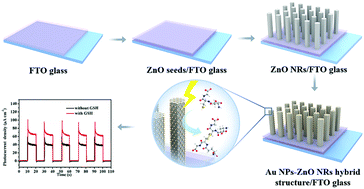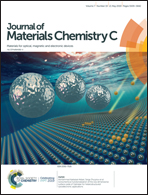Photoelectrochemical response to glutathione in Au-decorated ZnO nanorod array†
Abstract
Metal nanoparticle assisted photoelectrochemical (PEC) biosensing has attracted attention for point-of-care testing due to its fast and low background noise signal. However the interfacial charge transfer of plasmonic-enhanced biosensing is not yet fully understood. Herein, a plasmonic-enhanced PEC platform has been demonstrated for glutathione (GSH) detection based on a hybrid structure of a well-oriented zinc oxide nanorod array (ZnO NR) with gold nanoparticles (Au NPs) as photoanode. In the PEC system, the self-powered bioanalysis is carried out at 0 V versus Ag/AgCl under simulated sunlight. In detail, the optical experiments (e.g. photoluminescence, PL) and theoretical analysis (e.g. finite-difference time-domain, FDTD) illustrate the photoresponse enhancement mechanism of the Au NPs–ZnO NRs and reaction process of GSH. The GSH oxidization and the effect of pH on the photocurrent response are demonstrated and investigated. The as-prepared surface plasmon resonance (SPR) based PEC sensor could be considered for GSH detection for early diagnosis of tumors.



 Please wait while we load your content...
Please wait while we load your content...